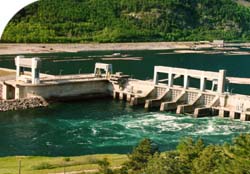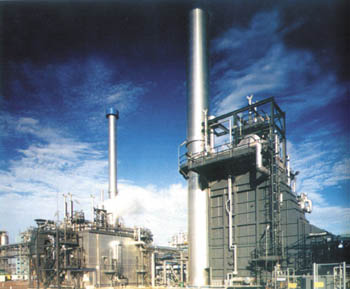On a large scale, manufacturing electricity is a matter of using some form of energy to turn a turbine that rotates a generator. In most cases, the potential energy in fossil fuels or falling water is used, but other possible sources include solar and wind. Thermal refers to the use of a heat source to produce steam or gas to turn the turbine/generator set. Hydro refers to electricity generated by directly falling water onto the turbine. Historically, British Columbia’s electricity industry had mainly been a hydro industry using the potential energy of BC’s rivers. First developed were those near the growing urban centres of Vancouver and Victoria and later the Kootenay River was harnessed to provide power for mineral processing. Smaller hydroelectric plants made use of coastal rivers to power pulp mills.
After World War II the electricity industry commenced on a long period of expansion that ended in 1982, with the completion of the Revelstoke Dam on the Upper Columbia River. With each round of expansion, the new plants were located further and further away from the major market in southwest BC. This distribution of generating plants required the construction of long-distance, high capacity transmission lines including links with the Pacific Northwest and Alberta. In contrast to the general pattern, two large plants were built close to the market. In 1954 ALCAN completed its Kemano project to supply the aluminium smelter in Kitimat, and in 1962 the BC Electric Company opened its gas/oil fired thermal plant on the north shore of Burrard Inlet in Greater Vancouver.


Today’s electricity industry is made up of utilities that sell electricity to all sectors of the market and own use industries that produce electricity primarily for use in their own industrial plants. The table summarizes the current installed capacity of the electricity industry by major type of owner and production facility. The major supplier is the BC Hydro and Power Authority (BCHPA) that is a crown-owned utility responsible to the government of British Columbia. The British Columbia Utilities Commission (BCUC) regulates the construction of generating plants and any proposal must receive an Energy Project Certificate (EPC) before development may commence.
An EPC is only issued after a project proposal has been through the Energy Project Review Process that is coordinated by the Energy Project Analysis Branch of the Ministry of Energy, Mines, and Petroleum Resources. This is an often-lengthy process that may involve as many as thirty-five local, provincial, and federal agencies, as well as public hearings at various stages.
|
Major Producers of Electricity in British Columbia (Installed Capacity 103 kW) |
|||
|
|
HYDRO |
THERMAL |
TOTAL |
|
UTILITIES |
9,819 |
1,134 |
10,953 |
|
BC Hydro and Power Authority |
9,622 |
1,124 |
10,756 |
|
West Kootenay Power and Light |
185 |
- |
185 |
|
Others |
185 |
- |
12 |
|
OWN-USE INDUSTRIES |
1,463 |
501 |
1,964 |
|
Forest Products |
80 |
474 |
554 |
|
Mineral Products |
1,376 |
13 |
1,389 |
|
Others |
7 |
14 |
21 |
|
GRAND TOTAL |
11,282 |
1,635 |
12,917 |